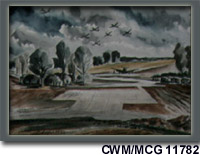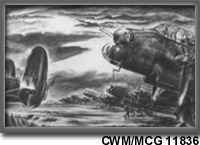"The war changed my life. Some of my best friends died in the war. When you see that much death and you are away from your native land, it colours your whole life. When you come back to normal life, you are changed. You can't explain why, any more than you can explain the taste of sugar." (6)
As an official war artist with the RCAF, Schaefer served with Fighter, Bomber and Coastal Commands in the United Kingdom and Iceland. The 221 paintings, sketchbooks, and war diaries retained in the art collection of the Canadian War Museum bear testament to war years richly lived and experienced.
Carl Schaefer was born in Hanover, Ontario, and attended the Ontario College of Art. The Group of Seven artists J.E.H. MacDonald and Arthur Lismer were among his teachers. In essence a landscapist, he found the countryside around his birthplace particularly inspiring, especially during the lean years of the 1930s. His fortunes as an artist turned when in 1940 he was awarded a Guggenheim Fellowship, which enabled him to paint full-time in New England. Three years later he was commissioned into the RCAF. After the war he taught for many years at the Ontario College of Art before retiring.
Of Schaefer's war years, George Johnston wrote:
"Its first effect was stimulating; the machines and aerodromes, and the lives of the airmen and airwomen fascinated him, and he seems to have grasped the idea of flight immediately as something he wanted to paint. It is the power of flight that one feels most strongly in his aeroplanes, whether they are airborne or on the ground. But there are ominous and brooding tones in all these pictures."(1)

|

|
| 'B' Flight Dispersal File | Marshalling Lancasters against Stuttgart |
In England for most of 1943, Schaefer spent time in Northern Ireland in 1944 and Iceland in 1945 before returning to Canada. He was promoted to the rank of flight-lieutenant in 1944 and released in June 1946. Of his own and his fellow artists' contribution to the record of the war he wrote:
"We did what we could under harrowing circumstances and at the same time we were close to what we did and understood through experience."(2)
His war work is composed entirely in watercolour, ink, or graphite. His diaries record vivid descriptions of practising his craft. On 13 January 1944 he notes:
"Made another watercolour from under [the] wing of C Charlie in Dispersal. Rain beating down, draining off wings, finally coming down on me in large drops through spaces around ... starboard Engine. Wind whipping around, tears off my paper from drawing board as water spatters all over watercolour. Finally finish."(3)
Like many artists of his generation he kept a sketchbook. The sketchbooks (CWM 19940015), shed a particularly lively light on aspects of wartime life that is not present in his more formal and larger paintings. While the diaries tell us that Schaefer narrowly escaped death when a London pub he was in was hit by a bomb, it is clear from the sketchbooks that the incident did not discourage him from further convivial meetings with friends and fellow artists such as the British painter Augustus John. Indeed, our knowledge of wartime pub life is recorded for posterity in the ebullient and swiftly drawn figurative sketches found in his sketchbooks.

|
|
